Last Stages of Sciatica: A Comprehensive Guide
This article explores the progression of sciatica, which specializes in its closing stages, wherein symptoms can end up extreme and debilitating. It discusses the causes, signs, and remedy options, inclusive of each conservative control and surgical intervention. The article also emphasizes the importance of early analysis and ongoing care to save you continual pain and everlasting nerve harm. Additionally, it affords strategies for coping with persistent sciatica and highlights the role of assist networks. Overall, it gives a comprehensive guide to know-how and coping with the superior ranges of sciatica.
Introduction
Sciatica is a situation that many people stumble upon in some unspecified time in the future in their lives. It’s a circumstance that frequently starts with slight pain however can boost to extreme ache or even disability if left untreated. The adventure from initial signs to the last levels of sciatica can be a hard and daunting procedure. In this article, we’ll explore what takes place within the final degrees of sciatica, the signs and symptoms, treatment alternatives, and a way to deal with the condition as it progresses.
Overview of Sciatica
Sciatica is a nerve pain that originates from the sciatic nerve, the biggest nerve within the human body. This nerve runs from the decreased lower back, via the buttocks, and down every leg. When something compresses or irritates the sciatic nerve, it may cause pain, which can range from mild to extreme.
Symptoms of Sciatica
- Sharp pain in the lower back or leg
- Numbness or tingling inside the leg or foot
- Weakness in the leg
- Difficulty standing or strolling
Causes and Risk Factors
Sciatica can be because of different factors which include a herniated disc, bone spurs, or spinal stenosis. Risk factors consist of age, weight problems, prolonged sitting, and jobs that require heavy lifting.
Over time, if the underlying motive of sciatica isn’t always addressed, the condition can worsen, leading to continual ache and incapacity. Understanding the ranges of sciatica is essential to preventing its development.

Stages of Sciatica
Sciatica progresses via numerous ranges, each with its own set of signs and demanding situations. Early intervention is prime to preventing the condition from accomplishing its very last, extra debilitating levels.
Stage 1: Initial Onset and Mild Symptoms
During the initial level, the symptoms are usually slight. You might enjoy a mild tingling sensation or a dull pain to your lower again or leg. This degree is often not noted, as the signs and symptoms may be intermittent and not overly bothersome.
Symptoms
- Mild lower returned aches
- Occasional tingling or numbness
- Slight discomfort while sitting or standing for lengthy periods
Diagnostic Methods
At this stage, a physical examination and possibly an X-ray or MRI can help in diagnosing the underlying purpose of sciatica.
Stage 2: Moderate Pain and Discomfort
As the situation progresses, the ache turns into greater importance and might begin to interfere with day-by-day activities. This is the stage wherein many human beings begin to seek medical recommendations.
Symptoms
- Persistent pain in the decreased back, buttocks, and legs
- Increased pain at some stage in the movement
- Occasional muscle weakness
Treatment Options
Conservative treatments like physical remedies, medicines, and lifestyle modifications are frequently endorsed at this level. Exercises aimed at strengthening the lower back muscle mass can be particularly useful.
Stage 3: Severe Pain and Functional Impairment
By this degree, the pain has commonly become intense and might significantly impact your capacity to perform day-by-day tasks. The nerve irritation or compression has likely worsened, main to greater excessive symptoms.
Symptoms
- Severe ache that radiates from the decrease again to the leg
- Difficulty in standing, walking, or maybe sitting
- Muscle weakness and numbness turning into greater said
Impact on Daily Life
The pain and soreness at this degree can severely restrict your mobility and decrease your first-rate lifestyle. Simple sports like bending down or strolling can emerge as excruciating.
Treatment Strategies
At this factor, a mixture of ache control strategies, along with more potent medications or nerve block injections, may be essential. Physical remedy keeps playing a role, but the attention would possibly shift to dealing with pain in preference to simply stopping further damage.
Stage 4: Chronic Sciatica and Last Stages of Sciatica
In the remaining stages of sciatica, the circumstance has usually grown to be chronic, meaning that the signs persist over a long period and are not likely to clear up without full-size intervention. This stage is characterized by using permanent adjustments in nerve features and ongoing pain.
What Happens in the Last Stages of Sciatica?
The final stage of sciatica is marked by ongoing, excessive pain and potential nerve damage. The sciatic nerve can also be compressed or angry for goodbye resulting in permanent modifications to the nerve’s features.
Permanent Nerve Damage
In extreme instances, the regular pressure at the nerve can lead to permanent nerve harm. This can result in a lack of sensation, a weak spot, or even paralysis within the affected leg.
Potential Complications
- Foot Drop: A condition in which you are unable to raise the front part of your foot, inflicting it to tug at the ground when taking walks.
- Loss of Bowel and Bladder Control: This is serious trouble and requires instantaneous scientific attention.
Symptoms inside the Last Stages of Sciatica
As sciatica progresses to its very last range, the signs and symptoms come to be extra extreme and debilitating. Understanding these symptoms is vital for dealing with the circumstance and in search of suitable treatment.
Intensified Pain and Discomfort
The ache within the final stages is frequently regular and excruciating. It might also radiate from the lower backpedal to the feet, making it hard to move or even rest.
- Loss of Sensation and Muscle Weakness: You can also enjoy significant numbness in your leg or foot, coupled with muscle weak spots. This could make it hard to carry out everyday obligations like strolling, climbing stairs, or maybe standing.
- Bowel and Bladder Dysfunction: In extreme instances, the nerve damage can amplify the nerves that manage bowel and bladder characteristics, leading to incontinence. This is a clinical emergency and requires immediate interest.
- Reduced Mobility and Quality of Life: The aggregate of pain, numbness, and muscle weak points can significantly restrict your mobility. Activities that you once enjoyed can also come to be impossible, mainly due to reduced satisfaction with existence.
Diagnosis and Assessment inside the Last Stages
Diagnosing sciatica in its closing stages includes an intensive examination of your clinical records, bodily assessments, and superior imaging strategies.

Medical History and Physical Examination
Your health practitioner will start by taking an in-depth medical history, focusing on the onset of signs and symptoms, their development, and any previous remedies. A bodily examination will investigate your reflexes, muscle energy, and sensation.
Imaging Techniques (MRI, CT Scans)
MRI and CT scans are commonly used to visualize the backbone and become aware of the purpose of nerve compression. These imaging strategies can display herniated discs, bone spurs, and different abnormalities that may be contributing to your symptoms.
Nerve Conduction Studies
These tests measure the electrical pastime of the sciatic nerve and can assist decide the quantity of nerve damage. They are especially useful in the later stages of sciatica whilst nerve function can be compromised.
Treatment Options for the Last Stages of Sciatica
Managing sciatica at its ultimate levels calls for a multi-faceted technique that may include conservative control, surgical intervention, and post-surgical procedure rehabilitation.
Conservative Management
- Physical Therapy: Even inside the remaining tiers, physical remedies can play a critical role in handling symptoms. A tailor-made program can assist hold mobility, fortify supporting muscle mass, and alleviate some of the pain.
- Pain Management (Medications, Injections): Pain management turns into a number one recognition within the remaining degrees of sciatica. Stronger ache medicines, together with opioids, may be prescribed. Epidural steroid injections can provide brief relief via decreasing irritation around the nerve.
- Lifestyle Modifications: Making modifications to your daily habits can help manipulate symptoms. This might consist of ergonomic modifications at work, keeping off prolonged sitting, and incorporating mild sporting events like swimming or taking walks into your habitual.
Surgical Interventions
When is Surgery Necessary?
Surgery is frequently taken into consideration when conservative remedies fail to alleviate symptoms, or when there may be giant nerve harm that might cause everlasting incapacity.
Types of Surgical Procedures
- Microdiscectomy: Removal of the part of the herniated disc that is pressing on the nerve.
- Laminectomy: Removal of part of the vertebra to alleviate strain on the nerve.
- Spinal Fusion: Joining or more vertebrae together to stabilize the backbone.
Rehabilitation Post-Surgery
Recovery from surgical treatment involves a length of rehabilitation, which includes physical remedy and slow reintroduction to regular activities. The purpose is to repair features and minimize the risk of recurrence.
Living with Chronic Sciatica
Coping with continual sciatica may be tough, however, some strategies assist you in managing your signs and preserving a good first-class life.
Coping Strategies for Daily Life
- Pacing Activities: Break duties into smaller, doable segments to avoid overexertion.
- Mindfulness Techniques: Practices like meditation and deep respiration let you manipulate ache and decrease stress.
- Assistive Devices: Using a cane or walker can assist hold mobility and decrease the danger of falls.
Psychological Impact and Support Systems
Living with persistent aches can take a toll on your mental fitness. It’s critical to are seeking for assist from the circle of relatives, friends, or professional counselors. Support agencies also can offer a feel of network and know-how.
Importance of Pain Management
Effective pain management is fundamental to living with continual sciatica. This might also contain a mixture of medicinal drugs, bodily therapy, and alternative treatments like acupuncture.
Preventing the Progression of Sciatica
While it may not usually be feasible to save you sciatica, there are steps you can take to reduce the risk of it progressing to its final stages.
- Early Intervention Strategies: The in advanced sciatica is identified and dealt with, the better the chances of stopping it from worsening. If you revel in symptoms, seek medical recommendations right away.
- Regular Exercise and Physical Therapy: Engaging in normal workouts, in particular activities that beef up the core and decrease returned muscle groups, can help prevent sciatica. Physical therapy also can deal with any muscular imbalances that might contribute to nerve compression.
- Ergonomic Adjustments and Lifestyle Changes: Making modifications to your workspace, including the use of an ergonomic chair, and heading off extended sitting can help lessen the strain on your decreased return. Maintaining a healthy weight and staying energetic also are crucial in preventing sciatica.
Prognosis and Long-Term Outlook
Understanding the lengthy-term outlook for sciatica allows you to manipulate your expectations and plan for the future.
Understanding the Likelihood of Recovery
Recovery from sciatica, particularly in its ultimate stages, can be gradual and won’t bring about the entire decision of symptoms. However, many human beings can control their signs and symptoms successfully with the proper remedy and lifestyle adjustments.
Managing Expectations for the Future
It’s critical to have practical expectancies approximately recovery. While some human beings may also revel in sizable development, others might also need to adapt to living with a few degrees of pain or pain.
Importance of Ongoing Care and Monitoring
Even after remedy, ongoing care is crucial. Regular check-u.S.With your healthcare company, endured physical remedy, and monitoring for any adjustments in signs are critical to save you from recurrence or in addition progression.
Alternative Therapies for Managing Last Stages of Sciatica
Exploring alternative healing procedures can offer additional remedies and supplement conventional remedies.

Acupuncture and Chiropractic Care
Acupuncture can help alleviate pain by way of stimulating particular points on the frame. Chiropractic changes may provide a remedy by realigning the backbone and lowering nerve compression.
Mind-Body Techniques (Yoga, Meditation)
Yoga and meditation can help control pain by way of promoting relaxation and improving flexibility. These practices also can assist you preserve a fine mindset.
Herbal and Nutritional Supplements
Some human beings find alleviation from sciatica symptoms through natural supplements like turmeric or omega-three fatty acids. However, it’s vital to visit a healthcare company before beginning any new complement.
The Role of Support Networks in the Last Stages of Sciatica
Having a strong support community is crucial while dealing with the closing degrees of sciatica.
- Family and Friends: Loved ones can provide emotional help, assist with each day’s tasks, and accompany you to medical appointments. Don’t hesitate to lean on them when wanted.
- Professional Support (Counselors, Support Groups): Professional counselors permit you to cope with the emotional impact of continual ache. Joining an assistant organization also can provide a feel of network and shared experience.
- Finding Community Resources: Look for network assets inclusive of pain management clinics, physical therapy facilities, or online boards in which you could hook up with others facing comparable demanding situations.
Conclusion
The final stages of sciatica constitute a challenging and often painful period for the ones affected. However, with the proper combination of treatments, lifestyle adjustments, and help, it’s viable to manipulate the signs and symptoms and hold a good best of life. Early intervention is key, and information on the progression of the circumstance can help in making informed selections about your fitness. If you watched you’re experiencing advanced degrees of sciatica, it’s critical to look for medical advice and discover all available remedy alternatives.
By staying proactive and running closely along with your healthcare crew, you could navigate the challenges of sciatica and take steps toward relief and healing.
FAQ’s about the Last Stages of Sciatica
Can Sciatica Be Cured in Its Last Stages?
Sciatica in its remaining levels may be hard to completely treat, but signs and symptoms can regularly be managed with a mixture of treatments.
How Long Does Recovery Take After Surgery for Sciatica?
Recovery times vary depending on the sort of surgical operation, but most people start to see development within some weeks to 3 months.
What Are the Risks of Not Treating Sciatica?
Untreated sciatica can cause everlasting nerve damage, persistent pain, and incapacity.
Is It Possible to Prevent the Last Stages of Sciatica?
Early intervention, ordinary exercise, and lifestyle changes can help prevent sciatica from progressing to its ultimate stages.
What Lifestyle Changes Can Help Manage Sciatica?
Maintaining a healthy weight, staying lively, and making ergonomic modifications to your day-by-day life can help control sciatica.
My Opinion about the Last Stages of Sciatica
In my opinion, knowing the closing levels of sciatica is crucial for anyone coping with persistent aches. Early intervention and consistent treatment can make a significant distinction in coping with the condition and preventing it from worsening. While the superior levels may be difficult, a mixture of medical care, lifestyle modifications, and strong assist systems can help individuals keep a good excellent lifestyle. It’s critical to take sciatica critically from the beginning and seek help before it becomes a greater severe issue.
Disclaimer about the Last Stages of Sciatica
The information furnished in this article is for academic and informational functions best and is not intended as medical advice. Always discuss with a certified healthcare expert earlier than starting any new remedy or making selections approximately your health. This article does not replace expert medical prognosis, treatment, or recommendation.







